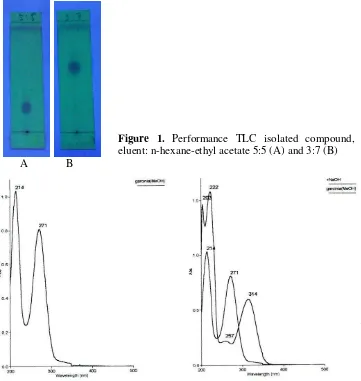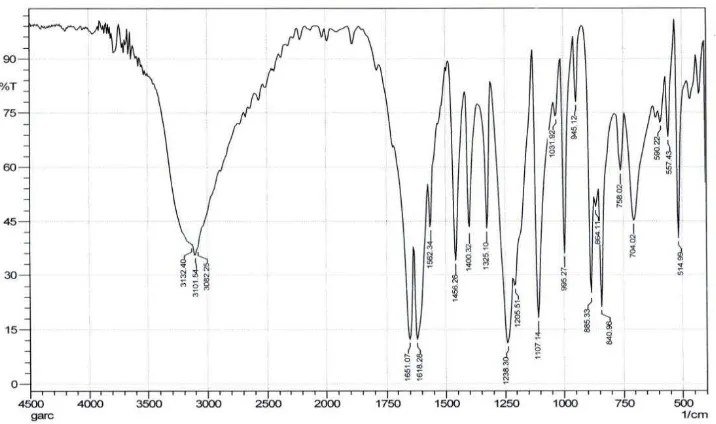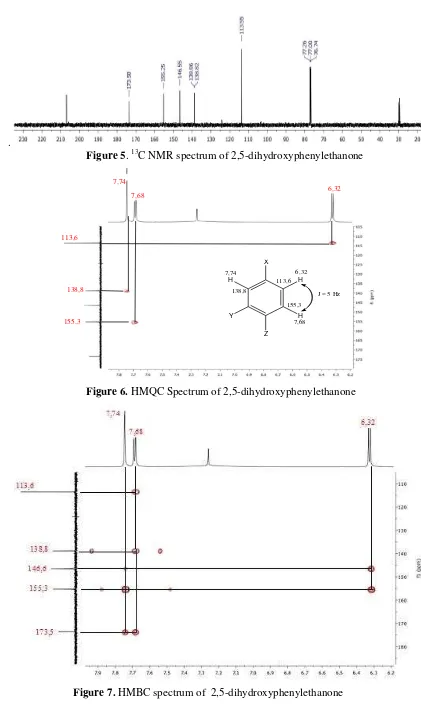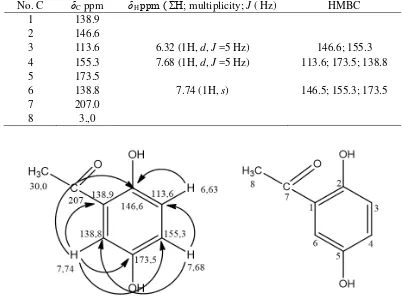ISOLATION AND EVALUATION OF THE ANTIOXIDANT ACTIVITY OF PHENOLIC CONSTITUENT OF THE Garcinia sizygiifolia
ISOLASI DAN EVALUASI AKTIVITAS ANTIOKSIDAN SENYAWA FENOLIK DARI Garcinia sizygiifolia
Muharni1*, Elfita1, Didi Pratama1 1
Department of Chemistry, Faculty of Mathematics and Natural Sciences Sriwijaya University, Palembang, Indonesia
*email: muharnimyd@yahoo.co.id
Received March 20, 2017; Accepted May 26, 2017; Available online May 30, 2017
ABSTRACT
Garcinia sizygiifolia is a native plant to the South Sulawesi region popularly known as sula and has been cultivated in several regions in Indonesia. The plant by local community use as a food and source of wood, but has not found information on chemical content and biological activity. Therefore, this study was carried out toIsolation and evaluation of the antioxidant activity of the phenolic constituent of the G. sizygiifolia. A 30.0 g portion of ethyl acetate extract of the stembark G. sizygiifolia were separated by column chromatography method using silica G 60 F254 (230-400 mesh), eluted gradient polarity mixtures of n
-hexane-ethyl acetate were collected and sorted into fractions. Fraction F 1 (5.2 g) were separated and purified again by chromatography method until pure compound obtained. The structure of the isolated compound was determined using UV, IR, and NMR spectroscopy. The antioxidant activity was tested by DPPH method. The isolated pure compound was a yellow solid with melting point 148-149 oC. Base on spectroscopy data and by comparison with data from the literature, isolated compound is a known compound 2,4-dihydroxyphenylethanone. The compound exhibited antioxidant activity with IC50 96 µg/mL against
DPPH.
Keywords: Antioxidant, dihydroxyphenylethanone, Garcinia sizygiifolia, phenolic.
ABSTRAK
Garcinia sizygiifolia merupakan tumbuhan yang berasal dari daerah Sulawesi Selatan dikenal dengan nama sula, dan telah dibudidayakan di beberapa daerah diseluruh Indonesia. Tanaman ini oleh masyarakat lokal dimanfaatkan sebagai bahan makanan dan sumber kayu, namun belum ditemukan informasi kandungan kimia dan aktivita biologisnya. Oleh karena itu, dilakukan penelitian untuk mengisolasi dan menentukan aktivitas antioksidan dari senyawa fenol dari G. sizygiifolia. Sebanyak 30 g ekstrak etil asetat kulit batang G.
sizygiifolia dipisahkan dengan metode kromatografi kolom menggunakan fasa diam silika G 60 F254 (230-400
mesh) dengan eluen kepolaran meningkat campuran n-keksana-etil asetat dan diperoleh fraksi-fraksi. Fraksi F1 (5,2 g) kembali dipisahkan dan dimurnikan dengan metode kromatografi sampai diperoleh senyawa murni. Struktur senyawa murni hasil isolasi ditentukan menggunakan data spektroskopi UV, IR, dan NMR. Aktivitas antioksidan ditentukan dengan metode DPPH. Senyawa murni hasil isolasi berupa padatan kuning dengan titik leleh 148-149 oC. Berdasarkan analisa data spektroskopi dan dibandingkan dengan data pada literatur senyawa hasil isolasi adalah senyawa yang sudah dikenal yaitu 2,4-dihidroksifeniletanon. Senyawa ini dengan metode DPPH menunjukkan aktivitas antioksidan dengan IC50 96 µg/mL
Kata kunci: Antioksidan, dihidroksifeniletanon, Garcinia sizygiifolia, fenolik.
INTRODUCTION
The genus Garcinia belonging to the family Guttiferae also called Clusiaceae with the most numerous genus and commonly as Rheedia. Many drug compounds were found from the genus of Garcinia with more than 1000 species widely distributed in tropical Asia, Africa, New Caledonia, Polynesia and Brazil (Piccinelli et al., 2005). In Brazilian Several species of the Guttiferae family are used in traditional medicine to cure
various ailments such as for treating cancer, hypertency and diabetes. In Thailand, Sri Lanka, Malaysia, the Philippines and India, parts used in traditional medicine ripe fruits are used to treat abdominal pain, diarrthea, dysentery, wound infections, suppuration and chronic ulcer (Cui et al., 2010).
digestive, and skin diseases. Base on literature having phenolic functional groups and ring three cyclic linear, so it has the biological and pharmacological activity of diverse. The groups of these compound gives rise to several interesting pharmacological properties were these constituens have been reported to several biological activities such as antibacterial activity (Dharmaratne, Yoshikazu, Piyasena, & Thevanesam, 2013), anti-inflammatory (Castardo et al., 2008; Santa et al., 2011), antioxidant (Gantijo et al., 2011), antitumour (Coelho et al., 2008) therapies, and anticancer activity (Sales et al., 2014).
Garcinia sizygiifolia known Indonesia name Sula is a small tree with prop roots and that endemic to south Sulawesi. The plant is obtained from the wild for local use as a food and source of wood, In Indonesia cultivated as a plant for vegetable. The root of this has been reported to Preservative, and fruit can to eat as pickle (Heyne, 1987). Base on literature study cannot provide information that chemical compound and biological activity. Preliminary test from ethyl acetate extract stem bark of Garcinia sizygiifolia showed contained phenolic compounds. Phenolic compounds usually showed active as the antioxidant (M. Maria, N. Susana, D. Susana, Ana, & A. Maria, 2014). In previous paper have been reported one compound polyprenylated benzophenone of the stem bark Garcinia sizygiifolia (Muharni, Elfita & Bastian, 2014).
In this paper will be reported the identification and the evaluation of the antioxidant activities of the main phenolic constituent of the stem bark G. sizygifolia.
Isolation begins with maceration extraction method was used to get the corresponding extracts of n-hexane, ethyl acetate, and methanol. Therefore, ethyl acetate fraction was subjected to further separation by column chromatographic methods to obtain the pure compound. The pure compound were analyzed by UV, IR, and 1H NMR dan 13C NMR and 2D NMR method. The antioxidant
DPPH method using ascorbic acid as deposited at the Herbarium Departement Biology Sriwijaya University
Material for isolation: silica gel 60 (70 -230 mesh.), thin layer chromatography (TLC) using Merck (Art.5554) silica gel 60 F254 (230-400), silica gel G 60 (70-230), methanol, n-hexane, ethyl acetate, dichloromethane, acetone. The organic solvents were used from distilled technical grade. Reagent for antioxidant activity: methanol p.a, DMSO (dimethyl sulfoxide), DPPH (1,1-diphenyl-2- picrylhydrazyl), and ascorbic acid.
Procedures
The extracts and fractions were concentrated using a rotary evaporator R-114 Buchi with vacum system Buchi B-169 under reduced pressure at 450 C. The ethyl acetate extract was purified by column chromatography (CC), using silica gel G 60 (70 -230 mesh) Merck as the stationary phase, eluted with increasing polarity mixtures of n-hexane-ethyl acetate and ethyl acetate-methanol. The substances were stained with 1% FeCl3 in ethanol reagent and visualized using ultra-violet CAMAG 254 nm, radiation (λ = 254 and 366 nm). Melting point is measured by Fisher Jhon melting point apparatus, UV spectrum was obtained with spectrofotometer ultraviolet Beck DU-7500. The IR spectrum was measured by FTIR-Perkin Elmer-Spectrum One ) using KBr pellets. The 1H and 13C NMR spectra measured on 500 MHz (1H) and 125 MHz (13C) on JEOL JNM ECA-500 spectrometer. The HMQC and HMBC contour maps were collected on a 500 MHz Varian. The invitro
continuous moisture monitoring. After the material was completely dry, it was pulverized in a knife grinder, producing 1000 g of ground sample. The dried, ground stem bark was subjected to exhaustive extraction in maceration apparatus using an increasing polarity solvent system, with n-hexane, ethyl acetate, and methanol as solvents for 24 h each. The extracts were then concentrated under reduced pressure, yielding 5.37 g of n-hexane extract, 40.41 g ethyl acetate, and 25.56 g of methanol.
Purification and isolation of chemical constituent
Ethyl acetate extract (30 g) was separated by column chromatography using silica G 60 F254 (230-400 mesh, eluted with step gradient polarity mixtures of n-hexane-ethyl acetate (1:0 → 0:1) were collected, analized by TLC and combined into five groups [F1 (5.2 g), F2 (1.7 g), F3 (3.9 g), F4 (4.2 g) and F5 (7.24 g)]. The 1st fraction (5,2 g) was further purified by rechromatographed using silica gel 60 (70-230 mesh), eluted with gradient polarity mixtures of n-hexane-ethyl acetate (10:0, 8:2, 6:4, 4:6, 2:8 and 0:10), and methanol. Base on TLC analysis to obtained five fractions F1.1 (0.4 g), F1.2 (0.8 g), F1.3 (1.3 g), F1.4 (0.9 g) and F1.5 (1.4 g). Furthermore, fraction 3rd (F1.3) was rechromatographed using the same method (silica gel, eluted with gradient polarity mixtures n-hexane-ethyl acetate (5:5 → 3:7) to yield three fraction Otherwise pure compound when the analysis by TLC with various eluent still give single spot and give the melting point with a small range (≤ 2).
Characterisation
The structure of the isolated compound was elucidated using UV, IR, 1H and 13C NMR, and NMR 2D HMQC, and HMBC spectroscopy and by comparison with data from the literature.
Evaluation of antioxidant activity
DPPH radical-scavenging activity the isolated compound in the evaluation according to the method of Gulcin et al., flask then add methanol until the volume 100 mL. This mixture was vigorously shaken at room temperature for 30 min. The absorbance of the mixture was then measured by UV-Vis spectrophotometer at λmaks 517 nm (Gulcin et al.,2005). The most effective radical scavenging activity was expressed with a low absorbance value. The isolated compound solution was analyzed in triplicate, and the average values were plotted to obtain the IC50 against DPPH by linear regression. The activity antioxidant of ascorbic acid, a recognized was used as a standard over the same range of concentrations. Determination of radical-scavenging activity declared as
sizygiifolia by chromatography tecnique. This type of chromatography is employed to separate semi-polar substances, which may be lost or obtained in low yield when separation by other chromatography techniques, due to irreversible adsorption use usual stationary phases such as silica. The isolated compound was as a yellow solid (50 mg). The purity test the isolated compound based on the analysis of TLC with different eluent n-hexane- ethyl acetate 5:5 and 3:7 showed a single spot with Rf values of 0.25 and 0.63 on the UV lamp at λ 366 nm (Figure 1).
A B
Figure 1. Performance TLC isolated compound, eluent: n-hexane-ethyl acetate 5:5 (A) and 3:7 (B)
Figure 2. UV spectrum of 2,5-dihydroxyphenylethanone
The compound was identified as 2,4-dihydroxyphenylethanone based on spectroscopic data UV, IR, 1H and 13C NMR, and NMR 2D HMQC, and HMBC spectroscopy and by comparison with data from the literature. The UV spectrum in MeOH (Figure 2) displayed absorptions at λ max at 214 nm and 271 nm for the pure compound. Adding NaOH produced absorptions at 222 nm and 314 nm The bathochromic shift in also of NaOH showed wavelength shift there λ max 214 nm to 222 nm and 271 nm to 314 nm, The shifts in the UV spectra produced by adding NaOH indicated the presence of phenol hydroxyl groups.
The IR spectrum (Figure 3) displayed absorption bands, λ max at 3405 (OH phenol), 3082 (C-H aromatic), 2927-2860 cm-1 (C-H aliphatic), 1618, 1562, and 1456 (C=C aromatic ), 1238 (C-O alcohol), 1651 (C=O
-1
around 1700, but if there is conjugation with a double bond will decrease the character of the double bond so that carbonyl absorption will occur at a lower wave numbers. Base on literature absorbtion at λ max at 1651 as C=O carbonyl conjugated with C=C (aromatic ring). The molecular structure of isolated compound, was determined by comparative analysis of the 1H NMR, 13C NMR HMQC and HMBC spectra the compound. The signals at δH 6.32 ppm (1H; d; J=5Hz) and δH 7.68 ppm (1H; d; J=5Hz) (Table 1) in the 1H NMR spectrum (Figure 4) base on coupling constants indicated the presence of aromatic hydrogen groupsas orto coupling (Creswell, Runquist, & Campbell, 1982). The signal at
Figure 3. IR spectrum of 2,5-dihydroxyphenylethanone
Figure 4. 1H NMR spectrum of 2,5-dihydroxyphenylethanone The 13C-NMR specrum (Figure 5) of
compound (Table 1) showed just eight signal carbon, seven carbon for C sp2 at δC 113.6, 138.8, 138.9, 146.6, 155.3, 173.5, and 207.0 ppm and one signal C sp3 at δC 30.0 ppm. 13
C NMR spectrum showed characteristic signals for a group of aromatic compounds, which are found only one signal on the chemical shift values below 100 ppm. This is also reinforced by the 1H NMR data. The signal at δC 207.0 characteristic fo C carbonyl at ketone in the form of cyclo. Base on literature study has been reported that genus
Garcinia rich sources of xanthones (Wu et al., 2013), flavonoids (A. Shukla, R, Shukla, Vikas, Dilip, & Jain, 2014), and benzophenone (Jantan and Saputri, 2012).
The group of these compounds has a basic structure with a carbon number of at least 13 signals, while the isolated compound has only eight signals carbon atoms. 13C NMR spectral data indicated isolated compound were not xanthone, benzophenone or flavonoid groups. NMR 2D analysis for HMQC spectrum (Figure 6) showing the proton at δH 6.32 ppm
correlation to carbon at δH 113.6 ppm and
proton at δH 7.68 ppm correlation to carbon
at δC 155.3 ppm. The proton at δH 6.32 ppm
the appearance of a long-range (2JCH) heteronuclear correlation with to carbon at δC 146.6 and 155.3 ppm in the HMBC spectrum (Figure 7) confirmed that it was linked to carbon that position of between 146.6 and 155.3 ppm carbon.
X
H
H
Z Y H
7,74 6,32
.
Figure 5. 13C NMR spectrum of 2,5-dihydroxyphenylethanone
Figure 6. HMQC Spectrum of 2,5-dihydroxyphenylethanone 7,74
7,68 6,32
138,8
155,3 113,6
138,8
113,6
155,3
X
H
H
Z Y
H
7,74 6,32
7,68
The proton at δH 7.68 ppm showed of a long-range (2JCH) heteronuclear correlation with to carbon at δC 113.6 ppm and δC 178.5 ppm in HMBC spectrum and (3JCH) to carbon
δC138.8 ppm. Base on This signal could be assigned to the hydroxyl group at δC 178.5 ppm but no correlation was observed between the protons hydroxyl with carbon at δC 155.3 or 138.8 ppm in the HMBC spectrum (Table 1, Figure 7). The proton at δH 7.74 ppm the appearance of correlation heteronuclear correlation with to carbon at δC 138.8 in HMQC spectrum and the appearance of a long-range (2JCH) heteronuclear correlation with to carbon at δC 138.9 and 173.5 ppm (Figure 8). The complete 13C and 1H assignments (Table 1), we determined that the structure the isolated compound was phenolic that 2,5-dihydroxyphenylethanone with molecular formula C8H8O3 with structure showed in Figure 8. This proposal is also strengthened by the similarity of spectroscopic data for 2,5-dihydroxyphenyl-ethanone in the literature (K. Trivedi, Tallapragada, Branton, D. Trivedi, & Nayak, 2015).
2,5-dihydroxyphenylethanone known by other names 2',5'-dihydroxy acetophenone and used cosmetic agents.Isolated compound base on Dictionary Natural Products data base 2,5-dihydroxyphenylethanone was not new compound which has been reported previously from the Chinese medicinal plant
Cynanchum auriculatum Royle ex Wight (Sun, Liu, Wang, & Zhu, 2009), and from the steamed root of Rehmannia glutinosa
Libosch and evaluated the effects of 2,5-dihydroxyacetophenone (DHAP) on inflammatory responses in lipopolysaccharide (LPS)-stimulated RAW264.7 mouse macrophages (Han et al., 2012) but it was new for Garcinia sizygiifolia. Exploration of secondary metabolites needs to be done in order to get the profile of organic compounds produced by Garcinia sizygiifolia. Base on literature study 2,5-dihydroxyacetophenone have been applied at sublimation provides efficient ionization of lipid species (Hayasaka, Naoko, Noritaka, Koji, & Mitsutoshi, 2014).
Table 1. 1H-NMR (500 MHz) and 13C-NMR (125 MHz), and HMBC spectral data of of 2,5-dihydroxyphenylethanone recorded in CD3OD.
No. C δC ppm δH ppm ( ΣH; multiplicity; J ( Hz) HMBC
1 138.9
2 146.6
3 113.6 6.32 (1H, d, J =5 Hz) 146.6; 155.3
4 155.3 7.68 (1H, d, J =5 Hz) 113.6; 173.5; 138.8
5 173.5
6 138.8 7.74 (1H, s) 146.5; 155.3; 173.5
7 207.0
8 3.,0
Antioxidant activity
The evaluation antioxidant activity of this compound used DPPH method base on absorption DPPH at λmaks 517 nm. Antioxidant reacts with 1,1-diphenyl-2-picryl hydrazyl, which is a stable free radical and converts it to 1,1-diphenyl-2-picrylhydrazine. The degree of discolouration indicates the scavenging potentials of the antioxidant compound (Meryem et al., 2016). Determination of antioxidant activity by DPPH method is a classical and simple method based on the reduction of DPPH (reduction of purple) to hydrazine ( yellow) (Gülçin, Alici, & Cesur, 2005). The reaction can be monitored spectrophotometrically by following the decrease in absorbance at 517 nm. The ability of a compound to reducing DPPH radical at a certain concentration, calculated by percent inhibition (% I). Standart antioxidant compound used ascorbic acid.
The activity of the compound is attributed to their hydrogen donating ability (Sravani and Padmaa, 2012). Antioxidants are believed to intercept the free radical chain of oxidation and to donate hydrogen from the phenolic hydroxyl groups, thereby forming the stable end product. The effectiveness of DPPH radical reduction determined by calculating the IC50 value through linear regression calculation, the concentration of test compound which can reduce 50% of DPPH radical. Based on the regression ascorbic acid were used as standards antioxidant produced IC50 values of at 6.0571 µg/mL against DPPH, and isolated compound showed IC50 values of at 96 µg/mL. According to Selvi, Joseph, and Jayaprakasha (2003) categorized as a pure compound has potent antioxidant activity when it has a value of IC50 <10 µg/mL. IC50 10-100 µg/mL categorized as active antioxidants and when have IC50> 100 µg/mL categorized as inactive. Based on this statement, the isolated compound considered active antioxidants but ts activity under ascorbic acid
Typical phenolics that possess antioxidant activity are known to be mainly phenolic acids and flavonoids (Maria et al., 2014). Phenolic acids have repeatedly been implicated as natural antioxidants in fruits, vegetables, and other plants. For example, caffeic acid, ferulic acid, and vanillic acid are
activity comparable to that of the flavonoid, quercetin. Flavonoid constituents found in plants are commonly are flavonol aglycones such as quercetin, myricetin, kaempherol, and their glycosides (Maria et al., 2014). Generally, flavonoid group that has several hydroxyl groups have higher antioxidant activity compared with the phenolic acids. However, the flavonoid glycosides (rutin, naringin, and hesperidin) usually have low antioxidant value. The antioxidant activities of flavonoids increased with the number of hydroxyl groups substituted on the B-ring, especially at C-3, and a single hydroxy substituent generates little or no additional antioxidant capacity (Rajalakshmi and Narasimham, 1996)
The high antioxidant activity of the phenolic group is often associated with the presence OH groups, which are potent H donors because electron delocalisation across the molecule efficiently stabilizes the resulting phenoxy radicals, which can be observed for the isolated compound. Another important feature the isolated compound is the planarity of the molecule, which permits conjugation and electron delocalisation. These factors are associated with an increase in radical stability. Intramolecular hydrogen bond between neighbouring –OH and C=O groups increase aromatic-ring conjugation and raise the H donation power of the molecule, because the resulting radicals are more delocalised (Jindai and Russell., 2010) The presence of a dihydroxy group ortho to the C=O moiety also increases antioxidant activity. Based on literature study low antioxidant activity of the isolated compound because has no ortho hydroxyl group and have not Intramolecular H-bonds between neighbouring –OH and C=O groups.
CONCLUSION
2,5-compound, but it was new for Garcinia D. A. (2008). Anti-inflammatory effects of ydroalcoholic extract and two biflavonoids from Garcinia gardneriana leaves in mouse paw (2008). 7-Epiclusianone, a tetraprenylated benzophenone, relaxes airway smooth muscle through activation of the nitric oxide-cGMP pathway. The Journal of Pharmacology and Experimental Therapeutics, 327(1), 206-214.
Creswell, C. J., Runquist, O. A., and Campbell, M. M. (1982). Analisa Spektrum Senyawa Organik. Bandung, Institut Teknologi Bandung.
Cui, J., Hu, W., Cai, Z., Liu, Y., Li, S., Tao, W. (2010). New medicinal properties of mangostins: Analgesic activity and pharmacological characterization of active ingredients from the fruit hull of
Garcinia mangostana. Pharmacology, Biochemistry and Behavior, 95, 166-172.
Dharmaratne , H. R. W., Yoshikazu, S., Piyasena, K. G. P., and Thevanesam, V. (2013). Antibacterial activity of xanthones from Garcinia mangostana
(L.) and their structure–activity relationship studies. Journal Natural Product Research, 27(10),938-941 Gontijo, V. S., Souza, T. C., Rosa, I. A.,
Soares , M. G., Silva , M. A., Vilegas, W., Júnior, C. V., and Santo, M. H. (2011). Isolation and evaluation of the antioxidant activity of phenolic constituents of the Garcinia brasiliensis
epicarp. Food Chemistry, 132, 1230-1235
Gulçin, I., Alici, H. A., and Cesur, M.(2005). Determination of invitro antioxidant and radical scavenging activities of
propofol. Chemical and
Pharmaceutical Bulletin, 53(3281), 281-285.
Han. Y, Jung H.W, Lee J.Y, Kim J.S, Kang S.S, Kim Y.S, and Park Y. K. (2012). 2,5- dihydroxyacetophenone isolated from Rehmanniae Radix Preparata inhibits inflammatory responses in lipopolysaccharide-stimulated
RAW264.7 macrophages, 15(6),505-510
Hayasaka,T., Naoko, G.I., Noritaka, M., Koji, I., & Mitsutoshi, S. (2014). Application of 2,5-dihydroxyacetophenone with sublimation provides efficient ionization of lipid species by atmospheric pressure matrix-assisted laser desorption/ionization imaging mass spectrometry. Surface and interface analysis, 46(12-13), 219-1222 Heyne, K. (1987). Tumbuhan Berguna
Indonesia Jilid III. Bahan Penelitian dan Pengembangan Departemen Kehutanan : Jakarta.
He Zhong ,J. Xiao, F. Q., Wei Xi, T., Jiang, M. H., Peng, C. W., Sheng, Z. H., Zhong, Q. C., Wen J L., Jun, Z., Xiao, F. M., and You, X. Z. (2010). Fatty acid synthase inhibitors of phenolic constituents isolated from Garcinia mangostana, Bioorganic & Medicinal Chemistry Letters, 20, 6045-6047. Jantan, I., and Saputri, F. C. (2012).
Benzophenones and xanthones from Garcinia cantleyana var. cantleyana and their inhibitory activities on human low-density lipoprotein oxidation and platelet aggregation. Phytochemistry. 80:58-63
Jindai and Russell, J. M. (2010). Plant Phenolics: Extraction, Analysis and Their Antioxidant and Anticancer Properties. Molecules, 15(10), 7313-7352
Meryem E, J., Rabie Kamal,1 Ilias Marmouzi,1 Asmae Zerrouki,2 Yahia Cherrah,1 and Katim, A. (2016). Radical-Scavenging Activity and Ferric Reducing Ability of Juniperus thurifera
(L.), J. oxycedrus (L.), J. phoenicea
(L.) and Tetraclinis articulata (L.), 1-6 Maria, G. M., Susana, N., Susana, A. D., Ana,
from Algarve, South Portugal. Food Sci. Technol, Campinas, 34(1): 16-23, Muharni, elfita, dan Bastian, P. P. S.(2014).
Benzofenon terpoliprenilasi dari kulit batang Garcinia sizygiifolia. Majalah ilmiah sriwijaya, vol XXV No. 18, 75-82.
Piccinelli, A. L., Cuesta-Rubio, O., Chica, B. M., Mahmood, N., Pagano, B., Pavone, M., Burano, V., and Rastrelli, L. (2005). Structural revision of clusianone and 7-epi-clusianone and anti-HIV activity of polyisoprenylated benzophenones. Tetrahedron, 61, 8206-821.
Rajalakshmi, D., and S. Narasimhan.(1996). Food antioxidants: Sources and methods of evaluation. Pages 65-158 in Food Antioxidants: Technological, Toxicological, and Health Perspectives. D.L. Madhavi, S.S. Deshpande, and D.K. Salunkhe, ed. Marcel Dekker Inc., New York, NY.
Santa, C. F. V., Vilela, F. C., Rocha, C. Q., Dias, D. F., Cavalcante, G. P., Freitas, L. A. S. (2011). Anti-inflammatory and antinociceptive effects of Garcinia
brasiliensis. Journal of
Ethnopharmacology, 133, 467–473. Sales, L., Pezuk, J. A., Borges, K. S.,
Brassesco, M. S., Scrideli, C. A., Tone, L. G., Santos, M. H., Ionta, M., and Oliveira, J. C. (2014). Anticancer activity of 7-epiclusianone, a benzophenone from Garcinia brasiliensis, in glioblastoma. BMC
Complementary and Alternative
Medicine, 15:393
Selvi, A. T, Joseph, G. S., and Jayaprakasha,G. K. (2003). Inhibition of Growth and Aflatoxin Production in Aspergillus flavus by Garcinia indica
Extract and Its Antioxidant Activity. Food Microbiology, 20: 455-460.
Sravani and Padmaa. (2012). Antioxidant activity of Hedychium spicatum Buch.- Ham. Rhizomes. Indian Journal of Natural Products and Resources, 3(3), 354-358
Shukla, A., Shukla, R., Vikas, P., Dilip, G., and Jain C. P. (2014). In-vitro Antioxidant activity of Garcinia Cambogia fruits. Journal of Medical Pharmaceutical And Allied Sciences, 03, 67-73
Sun, Y., Liu, Z., Wang, J., and Zhu, L. (2009). eparation and Purification of Baishouwubenzophenone, 4-Hydroxyacetophenone and 2,4-Dihydroxyacetophenone from
Cynanchum auriculatum Royle ex Wight by HSCCC. Chromatographia
70, 1-2.
Trivedi, M. K., Tallapragada. R. M., Branton, A., Trivedi, D., and Nayak, G. (2015). Physical, Thermal and Spectral Properties of Biofield Energy Treated 2,4-Dihydroxybenzophenone Clin Pharmacol, Biopharm 4(4) 145. Takahiro, H., Naoko, G. I., Noritaka, M.,
Koji, I., and Mitsutoshi, S. (2014).
Application of
2,5-dihydroxyacetophenone with sublimation provides efficient ionization of lipid species by atmospheric pressure matrix-assisted laser desorption/ionization imaging mass spectrometry. Surface and Interface Analysis, 46, 12-13, 1219–
1222
Wu, Y. P., Zhao, W., Xia, Z. Y., Kong, G. H., Ping, X., Hu, Q, F., Gao, X. M. (2013). Three Novel Xanthones from



